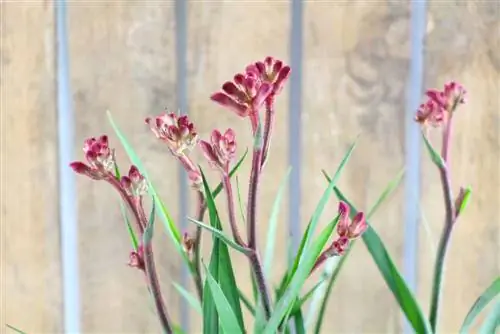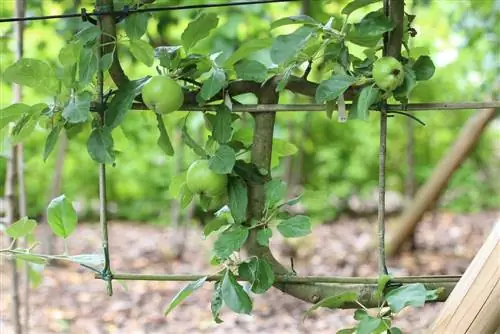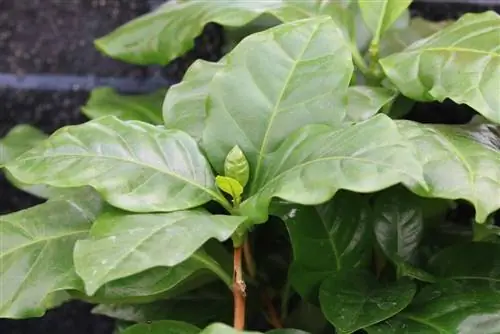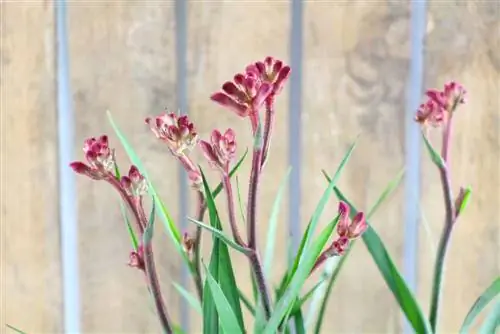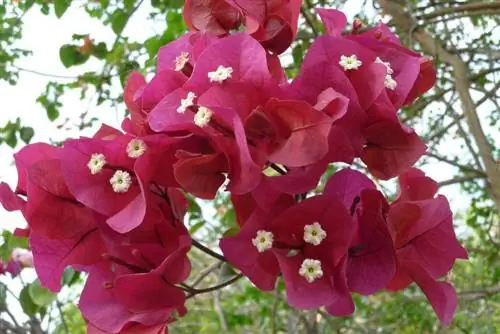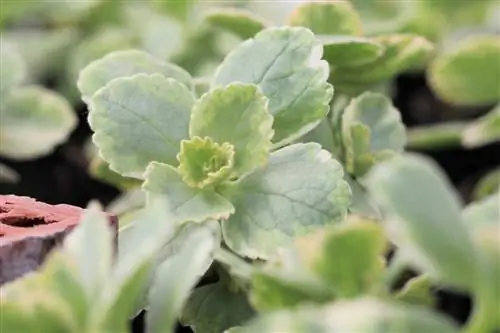- Author admin [email protected].
- Public 2023-12-17 03:39.
- Last modified 2025-01-24 12:45.
The kangaroo paw is an exotic plant that got its name because of the unusual flower shape. Several tubular individual flowers are crowded together in the inflorescences, so that they are reminiscent of the paw of Australia's national animal. Unlike the kangaroo, this plant does not prefer dry and hot conditions. In order for Kangaroo Paw to thrive in Central European regions, special care instructions must be taken into account.
Profile
- scientific genus name: Anigozanthos
- Genus contains ten species as well as several subspecies and varieties
- Plants move into natural habitats during the dry season
- sprout again as perennial plants after the winter rain
- Inflorescences of some species grow up to 150 centimeters high
- Flowers are hermaphrodite and have conjoined bracts that are woolly hairy
Location
The kangaroo paw is considered to love warmth. A partially shaded window sill facing west or east with bright lighting conditions is an ideal location for Anigozanthos species. Bright rooms with indirect light support flower formation. The flowering period of this exotic plant extends throughout spring. The sunny south window is also tolerated if the room is ventilated regularly and the care instructions are followed. Kangaroo Paw is a real houseplant, but likes to take a warm spot on the balcony and terrace during the summer months. In addition to optimal lighting conditions, the prerequisite is an airy location so that the heat does not build up.
Note:
Protect the tropical plant from drafts and rain. The kangaroo paw doesn't particularly like such conditions.
Substrate
The kangaroo plant prefers a substrate with a loose structure that ensures optimal water drainage and stores water at the same time. Clay granules and quartz sand are ideal for improving the coarseness of the soil. To improve water retention, you can add cocohumer to the soil. Make sure that the substrate is lime-free. If the lime content is too high, over time the absorption of water and nutrients will be negatively affected. A substrate with a pH value of 6.0 is ideal. These substrates prove to be well suited:
- Azalea substrate
- Leaf or bog soil
- Orchid substrate
- Potting soil or peat substitute
Pouring

The water requirement of the kangaroo plant is in the medium range. In natural habitats the soil is always moist. When cultivating in a pot, you should ensure that the substrate neither dries out completely nor becomes waterlogged during the growing season between spring and autumn. Moderate watering is enough to nourish the plant. Pour off excess water from the saucer or planter. How to water correctly:
- Let the top substrate layer dry before each watering
- Avoid tap water and use rainwater
- water at the base of the stem so that flowers and leaves stay dry
Kangaroo Paw cannot tolerate waterlogging. If the plant is permanently in wet soil, the fine roots die off. Here various fungal spores find optimal living conditions and entry points. They grow and accelerate the rotting processes. To prevent this, you should equip the bottom of the pot with drainage. Use durable materials such as lava grit, pottery shards or gravel. Fill the pot to a height of three centimeters with the material before planting the plant.
Fertilize
The kangaroo paw is one of the plants that need an optimal supply of nutrients from spring to summer. To avoid over-fertilization, you should use a slow-release fertilizer. Too high concentrations of various minerals can negatively affect growth. The long-term fertilizer is administered via irrigation water at the beginning of the growth phase. Alternatively, you can use a conventional liquid fertilizer that you give your plant in low concentrations every two weeks. Make sure that the fertilizers are lime-free.
Note:
Fertilization is stopped at the latest when the plant prepares for winter. This process starts for the kangaroo plant in August.
Cutting
Although this exotic plant can reach up to 60 centimeters in height and width, regular pruning is unnecessary. You can cut off dead leaves and shoots close to the ground as soon as they have completely dried out. Withered inflorescences are cut off to encourage the formation of new shoots. When pruning, use sharp secateurs that have been thoroughly cleaned and disinfected. This will prevent pathogens from being transmitted. Wear gloves, as some Anigozanthos species contain latex in their ducts.
Wintering
The non-hardy plant requires a mild and bright winter quarters in which it is protected from frost and cold. If Kangaroo Paw is allowed to stand outdoors during the summer months, the plant should be brought indoors by October at the latest. The ideal temperatures for wintering are between ten and 15 degrees Celsius. In winter the kangaroo paw stops growing. Do not allow the plant to dry out completely and do not fertilize. Such overwintering is necessary so that you can enjoy the flowers again next year. As winter comes to an end, you should follow these care instructions:
- Slowly increase watering from the beginning of March
- place on a shady windowsill for the first two weeks
- get used to the sun gradually
- put outside after the Ice Saints in mid-May
- Make sure you choose a partially shaded location to avoid burns
Tip:
Before you put the plant outdoors, you should cultivate it for about five weeks under consistent conditions at 14 degrees Celsius. This increases the chance of lush flowers.
Propagate
The kangaroo plant can be propagated vegetatively and generatively. The former method refers to the reproduction of the plant via roots or shoots. Generative propagation is possible because Anigozanthos species fertilize themselves. Since division is time-consuming and, like propagation via cuttings, can damage the mother plant, you should grow your plants from seeds. Kangaroo Paw is easy to propagate via seeds. You can rarely find seeds in specialist shops, which is why you have to use the seeds from a mother plant. If you follow the care instructions, the plant will bloom regularly.
Rhizome division
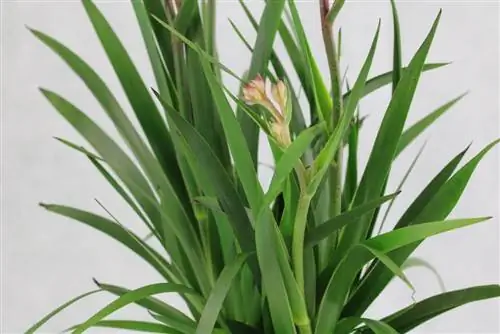
Older plants that have developed a strong rootstock and grow lushly can be divided carefully. Make sure the kangaroo paw is he althy. You can divide the plant throughout the growing season. Either you carry out this measure as part of the repotting, or you separate the rhizome shortly before the rest phase begins. This gives the partial plants time to grow. Follow these steps:
- Lift the root ball out of the pot and knock off the substrate
- Remove soil residue from rhizome
- use a sharp and disinfected knife
- separate one or two secondary tubers so as not to weaken the plant
- Allow interfaces to dry
- Planting mother plant and rhizome pieces
Cuttings
Cut he althy and strong shoots from the mother plant. Let the cutting “bleed” under lukewarm water until no more milky juice comes out of the cut. The shoot is then placed in a glass of water, which is placed in a bright and warm place. It takes about two to three weeks for the first roots to form. Once they have reached a length of two centimeters, the cuttings are planted.
Sowing
Let the seeds ripen and collect them before the fruits dry out completely. The older the seed, the worse the germination rate. Scatter the fine seeds on a nutrient-poor substrate and press them lightly. Make sure that the grains are not covered with soil. Gently moisten the substrate with a sprayer and place the sowing container in a bright and warm place. At daytime temperatures between 18 and 22 degrees Celsius, the seeds germinate after 21 to 28 days. At night the thermometer should not fall below 13 degrees. The seedlings can be separated as soon as they have developed the first pair of leaves.
Repotting
As a houseplant, your kangaroo paw will thank you for regular repotting. Treat the plant to a larger container every two to three years. If the pot becomes too small, you should choose a larger planter. The ideal time for this measure is spring, shortly before the new growing season begins. Choose a pot that has two to three centimeters more circumference. Create drainage and cover this layer with fresh substrate. Insert the root ball and fill in the gaps. Gently press the ball down and water the plant thoroughly. This closes air holes and allows the roots to come into contact with the earth.
Diseases
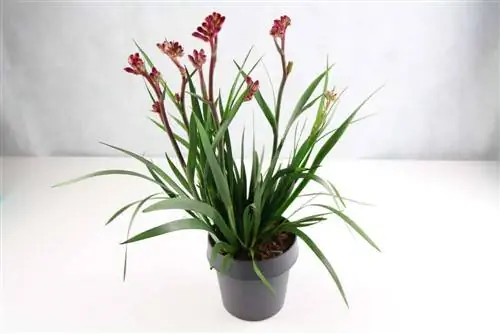
One of the most common diseases of the kangaroo plant is root rot. It occurs when the substrate is too waterlogged and the roots suffer from waterlogging. They rot in the absence of air and provide an optimal breeding ground for fungal spores. Root rot can be recognized by a musty smell and brown, mushy roots. Cut out the affected areas generously and place the plant in fresh substrate.
Pests
Aphids and spider mites are common pests on Kangaroo Paw. The sucking insects mainly attack young and weakened plants. Older specimens can hold their own against the pests. Aphids can be recognized by the honeydew that covers leaves and shoots. Spider mites develop typical webs that become visible through the water atomizer. To prevent the spread of pests, you should consider these aspects:
- avoid dry heating air
- Strengthening plants with plant manure
- Use yellow boards for control
If the pests have spread significantly, you should wipe the leaves with a damp cloth. You can spray the plant with neem oil. Use beneficial insects such as lacewing larvae or predatory mites. These feed on the pests.

